
The Cephalopoda
Squids, octopuses, nautilus, and ammonites
|
FUN FACT: From the dark abyss to shallow tide pools, research has recently revealed some of the mysterious behaviors of two famed cephalopods, the Giant Squid and the deadly Blue-ringed octopus (click image below for an enlargement). |
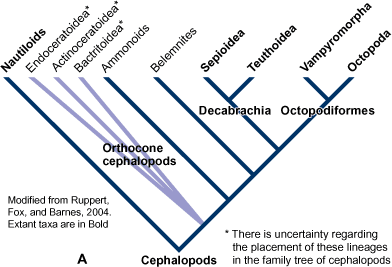 |
More familiar to us in the fossil record are the nautiloids, ammonoids, and belemnites.
Nautiloids and ammonoids
Nautiloids are the earliest cephalopods found in the fossil record, appearing by the Late Cambrian. The earliest forms were orthoconic (having straight shells), but during the Ordovician the nautiloids experienced a rapid diversification and evolved a planispiral (coiled in a single plane) shell shape. All have shells with nacre and interconnected internal chambers, similar to what we see in the modern nautilus. This morphology is very similar to many of the ammonoids, which first appear in coiled form in the Devonian Period. Though nautiloids and ammonoids may appear the same, they are easily distinguished by the location of their siphuncle and the shapes of their sutures.
 The photo on the left shows the position of the siphuncle in ammonoids. The other two are of nautiloids exhibiting the simple sutures typical of the group. |
The siphuncle is an internal tube that runs through and connects the chambers of the shell. In nautiloids, it runs through the center of the shell chambers, while in almost all planispiral ammonoids, it is found along the shell's outer edge (above left). Sutures are contact lines between shell chamber walls (called septa) and the inner shell wall of nautiloid and ammonoid shells. In nautiloids these lines are straight and are called simple sutures (above center and right). In contrast, ammonoid sutures dip and fold in undulations called lobes and saddles (below left). The most undulated, complex sutures are found in the prolific ammonoids of the Cretaceous, the ammonites (below right). One pattern of change in the evolution of ammonoids as a clade is that their suture morphology became more complex with time. That is, ammonoids from the Cretaceous have sutures with more intricate lobes and saddles than those of their relatives from the Permian 200 million years earlier.
 Hildoceras bifrons (left) illustrates the typical lobes and saddles of ammonoid sutures. The sutures on the ammonite (right) are even more complex. |
|
FUN FACT: Ammonoids, like belemnites, have also played a notable role in folklore. During the Middle Ages, their coiled shells were interpreted by the English, who encountered them in Jurassic-aged rocks exposed throughout Great Britain, as lithified snakes (called "snake stones"). Similarly, ammonite fossils encountered by the early Romans were mistaken for horns, and termed "ammonites" for the coiled horns of the Egyptian ram-god Ammon. |
Shell morphology: Another characteristic unique to ammonoid cephalopods is that although most were planispiral, the shells of some species were wide, open-coiled, kinked, twisted, or hooked. The implications of these shapes on the animals' behavior and lifestyle could be profound, but how could it be tested? The answer is through inference. One way paleontologists infer function from an organism's shape or form, is through experimentation and comparison with living animals. In this case, paleontologists measured buoyancy and hydrodynamic characteristics of Nautilus, and compared their results to actual tests of ammonoid shells and models in a water flume. They found that planispiral shell shapes (like a discus) were able to move through the water quickly, while wider and more open shell shapes moved more slowly. These morphologies could mean that planispiral cephalopods lived an active, pelagic lifestyle and wider shelled ammonoids lived near the ocean bottom and were slow movers. Dramatic curves, twists, as well as highly ornate ammonoid shells also suggest that those animals were relatively slow movers inhabiting a quiet marine environment.
Belemnites
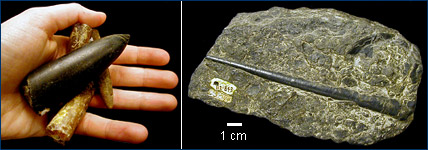 The rostrum of belemnites is the part most frequently preserved (left). At right, a long belemnite rostrum in a block containing other marine fossils. |
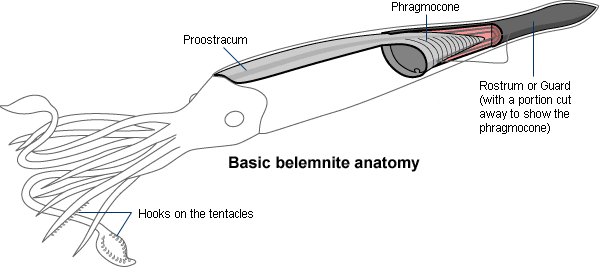 |
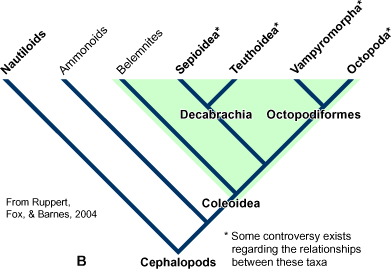 |
Life history & ecology
Three main clades are typically identified within the Cephalopoda (cladogram B, left): the Ammonoidea (an extinct and shelled clade), Nautiloidea (with only one living shelled genus, Nautilus) and Coleoidea (squids, cuttlefish, octopuses, the Ram's Horn Squid, the "paper nautilus," and an extinct clade, the belemnites). The ammonoid lineage survived for 300 million years in the oceans of the Paleozoic and Mesozoic. Most had planispiral (coiled in a single plane) external shells, and throughout their evolutionary history these plentiful predators shared the seas with the nautiloids, a clade of less diverse shelled cephalopods. By the end of the Cretaceous Period however, extinction had wiped out the ammonoids entirely and left only one surviving nautiloid clade, the genus Nautilus. Today, the only living representatives of shelled cephalopods are a few species of Nautilus. These molluscs are slow-moving, restricted to deep water, and have coiled shells that are similar to those of their fossil ancestors.
 From left, the exterior shell of the extant Nautilus; a cross-section of the Nautilus shell; the internal shells of the Ram's Horn Squid (Spirula spirula); and the secreted external papery shell-like brood pouch of the female Paper Nautilus (Argonauta sp.). |
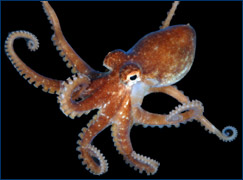 A female Octopus digueti. |
|
FUN FACT: In 2006, a UC Berkeley graduate student reported that the Indonesian Coconut Octopus, Octopus marginatus, can move along the ocean floor using only the tips of its arms, almost like "walking." See Crissy Huffard's "Walktopus." |
 |
More on morphology
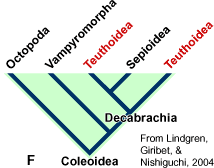 |
The eye. No presentation of cephalopods would be complete without a discussion of the cephalopod eye. This structure is probably the most sophisticated eye of all invertebrates and is as complex as the vertebrate eye, though the two are not homologous. For their body size, cephalopod eyes are relatively large. They contain an iris, pupil, and lens, but not necessarily a cornea. Octopuses are the only cephalopods with a completely protected "closed" cornea. That means that the eyes of squids and sepioids (cuttlefish, etc.) are in direct contact with sea water! The pupil in cephalopods is unique in that its morphology is different in octopuses, cuttlefish, and squid. Octopuses have a slit-shaped rectangular pupil. In cuttlefish it is W-shaped, and in squid it is round (see below). In Nautilus the eye is much simpler. It is mounted on a stalk, has no lens, and has a very small pupil (1-2 mm). It can narrow and widen in different brightnesses but resolves images poorly, so probably is useful only to detect light.
 Differing eye morphologies in cephalopods. From left, a squid (Loligo), octopus, cuttlefish, and Nautilus. Note the hyponome below the octopus eye — this is a muscular tube, that when contracted, expels water in a jet, propelling the octopus backwards. The hyponome can be aimed in various directions, giving the octopus finer control over its escape route. |
Arms and tentacles. Arms and tentacles are another distinguishing cephalopod characteristic. All cephalopods have arms, but not all cephalopods have tentacles. Octopuses, cuttlefish, and squid have eight non-retractable arms, but only cuttlefish and squid (Sepioidea and Teuthoidea) have tentacles (two each). Arms usually have cirri (fleshy papillae/palps), often suckers, and sometimes hooks (modified suckers) along their undersides. These can be attached to the arm directly or by a flexible stalk and are used to adhere to substrates and catch prey. Tentacles are longer than arms, are retractable, and usually have a blade-shaped or flattened tip, called a club, which is covered in suckers. Squid and cuttlefish have one pair of tentacles and they use these to strike quickly at prey.
|
FUN FACT: The largest cephalopod Mesonychoteuthis hamiltoni, (Fig. 17) called the colossal squid, is longer than a city bus, while the smallest cephalopod, Idiosepius notoides, the pygmy squid, could fit on your fingernail. |
|
FUN FACT: A hectocotylus is a cephalopodic arm of a male, modified to deliver a spermatophore (sperm-containing sac) to a female. In some taxa, part of this arm can detach from the male and remain inside the female. In 1829, the famous naturalist George Cuvier first identified and described a hectocotylus in the paper nautilus (an octopus of the genus Argonauta) but, at the time he thought that this detached arm was a parasitic worm! He named it Hectocotylus octopodis. When it was discovered that the "worm" was really a cephalopod arm, the name "hectocotylus" was kept but its meaning changed to refer to the spermatophore-transferring arm of any male cephalopod. |
Some pelagic squids possess an additional color-changing structure; the light organ. A pair of these light organs is located within the mantle cavity on the underside of the squid. Each contains a crypt and a lens. A crypt is a small sac that houses luminous bacteria and a lens is a complex stack of tiny reflecting plates that controls the luminescence of this bacteria. Light from the bacteria projects downward and the squid can manipulate its intensity to match any light coming from above. This masks the squid's own silhouette, protecting it from potential predators.
The brain. Finally, one of the most intriguing aspects of cephalopods is their intelligence. With a centralized brain, the largest of all invertebrates, and highly developed eyes and other sense organs, they are able to remember and learn by example or through trial and error.
References and resources
Web resources
Original text by Jann Vendetti, UCMP, 2006. Blue-ringed octopus (adult and baby) and Octopus digueti photos by Roy Caldwell, Integrative Biology and UCMP, UC Berkeley; ammonoid, nautiloid, belemnite, Nautilus shell, Ram's Horn Squid, and paper nautilus photos by Jann Vendetti, UCMP; cephalopod eye morphology and Octopus bimaculoides photos © Larry Jon Friesen.